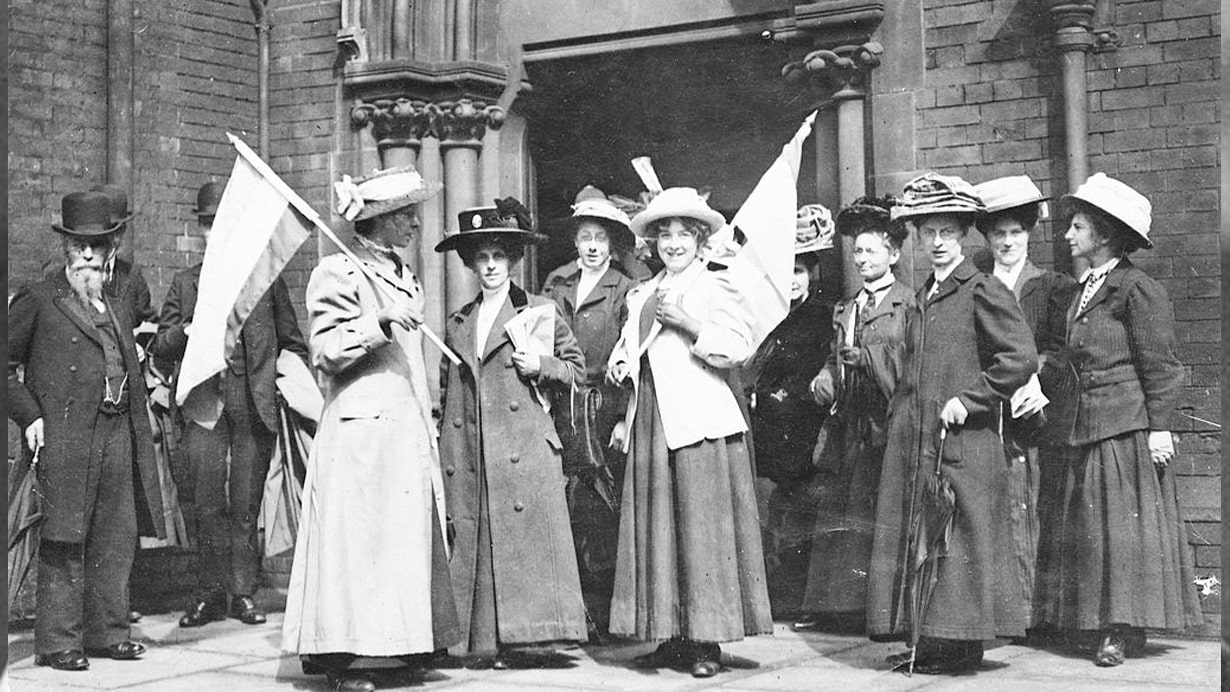
Read more about Popular Culture

In Victorian times, democracy was a male privilege; not just in Britain but all over the world (unless you happened to live somewhere like Sweden or Corsica). Unable to vote, own property or sue, women were effectively second-class citizens. But things were starting to change.
As the industrial revolution put more women into work, for the first time they had the freedom to congregate and talk politics. “The Cause”, a broad campaign for women’s rights, emerged. But if women couldn’t vote, why should politicians listen to what they had to say?
Organised campaigns for the right to vote, or “suffrage” first appeared in 1866, and become a central focus by the end of the century. In 1867, MP John Stuart Mill proposed an amendment, giving women the same voting rights as men. Though the vote lost by 194 votes to 73, Mill’s championing of the issue inspired many men and women to join the movement. Among them was Millicent Fawcett, who became a convert to the movement, aged 19, after hearing Mill speak in 1866.

In 1897, the National Union of Women's Suffrage Societies (NUWSS) formed, and Fawcett became its president. The group followed peaceful, law-abiding tactics, such as non-violent demonstrations, petitions and lobbying MPs. Fawcett believed this was the only way to win the argument. By 1900, its broad support-base included several MPs. Bills supporting women's right to vote gained significant support in Parliament; albeit not enough to win. Some believed it was only a matter of time before the law was changed; others were less convinced.
Emmeline Pankhurst and her daughter Christabel Pankhurst helped found the Women’s Social and Political Union (WSPU) in 1903 under the motto “deeds not words”. A former member of the Manchester suffragist group, Pankhurst was frustrated by the lack of progress, and believed stronger methods were needed.
As the national media lost interest in women’s suffrage, Pankhurst’s WSPU recaptured publicity through noisy public demonstrations, where any arrests were a bonus. Christabel and Annie Kenney were the first members to be imprisoned in October 1905, after they heckled the Liberal politicians, Winston Churchill and Sir Edward Grey at a public meeting.
The Daily Mail writer, Charles E. Hands, first coined “suffragette” as a patronising jibe for WSPU members in 1906. The group reclaimed the word, however, hardening the “g” so that the word was pronounced “suffragette”, implying they would get suffrage.
The Women’s Freedom League (WFL) was formed in 1907, when 70 members split from the WSPU, following a row with the Pankhursts. They believed in radical methods, like withholding taxes, but unlike the WSPU, they did not support violence.
The WSPU’s membership continued rising; by 1909, it had branches nationwide and its newspaper, Votes for Women, sold 20,000 copies a week. The WFL built a smaller national presence, with its own paper, The Vote. Including the NUWSS, three distinct groups with different approaches were now fighting for the same cause.
In July 1909, Marion Wallace Dunlop went on hunger strike in prison and was released on medical grounds. This became a standard suffragette protest over the government’s refusal to grant them “political prisoner”-status. In September 1909, force-feeding was introduced.
In March 1910, Home Secretary Winston Churchill allowed suffragettes who had not committed serious offences “political prisoner” privileges, temporarily ending hunger strikes.
From 1912 onwards, the WSPU grew more militant and more violent. Politicians were attacked on their way to work and their homes fire-bombed. Suffragettes burned down churches, chained themselves to Buckingham Palace and vandalised Oxford Street.
Hunger strikes started anew and the Government hit back with the Cat and Mouse Act in April 1913. Under the Act, they let suffragette prisoners starve, releasing them when there were health concerns, only to re-arrest them, on trivial grounds, once they had recovered.
The suffragettes swiftly formed the Bodyguard, whose members, including Katherine Willoughby Marshall and Gertrude Harding violently defended prominent suffragettes from the police.
On 4th June 1913, Emily Davison leapt in front of the king’s horse at the Epsom Derby; dying of her injuries. It was never established whether she intended to kill herself. 50,000 people marked her funeral procession across London.
When the First World War began, The Pankhursts called off all action to support the wartime effort. Fawcett’s NUWSS, the WFL and other breakaway suffragettes, many of whom were pacifists, continued campaigning. Women played a vital role wartime Britain. As the WSPU’s new-found “patriotism” won over public opinion, the NUWSS gradually achieved co-operation with the Government on the issue.
In 1916, the Prime Minister, Asquith, made a declaration supporting women’s suffrage. In the same year, Lloyd George, who had always been sympathetic to the cause, replaced Asquith as Prime Minister, and many more pro-suffrage MPs gained influential positions in Government.
On 6 February 1918, the Representation of the People Act was passed, which allowed women over 30, meeting minimum property qualifications, to vote. Many MPs supporting the motion cited women’s huge contribution during the war as a major factor in their decision. In 1928, the Equal Franchise Act was passed allowing all women over 21 to vote and giving them complete voting equality with men.